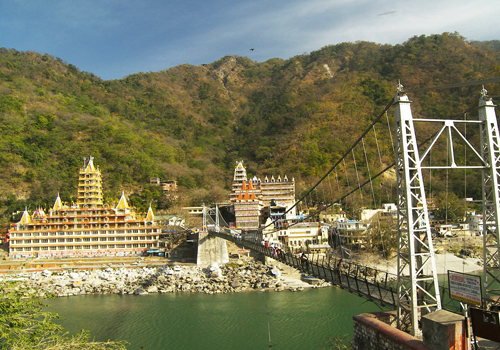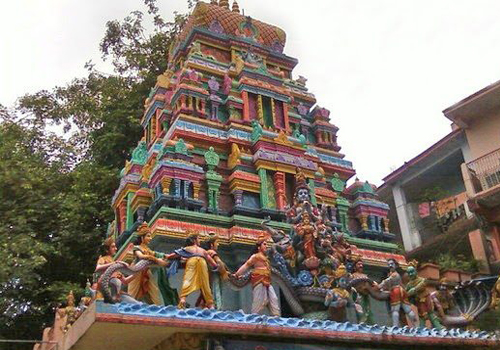
Near the Ghat, is the temple known as Bharat Mandir said to be the oldest temple here built by the Adi Shankaracharya. This 9th century temple has the deity of Lord Vishnu carved out of a single black stone popular as Saligram, and is placed in the inner chambers of the temple. The original temple was said to have been destroyed in 1398 AD. If you are lucky, catch the spring festival also called Basant Panchami celebrated here.
laxman jhula is an iron suspension bridge over holy river ganga at rishikesh . a famous landmark place in rishikesh , laxman jhula is 450 feet lenght connecting pauri district with tehri district . laxman jhula also offers a panoramic view of river ganga and rishikesh city having number of temples.


Neelkanth Mahadev Temple is a Hindu temple dedicated to Nilkanth, an aspect of Shiva. The temple is situated at a height of 1330 meters and is located about 32 km from Rishikesh in the Pauri Garhwal district of Uttarakhand, India. The temple is one of the most revered holy shrines dedicated to Lord Shiva and is a prominent Hindu pilgrimage site. It is surrounded by dense forests and is adjacent to the mountain ranges of Nar-Narayan. It is enveloped between the valleys of Manikoot, Brahmakoot and Vishnukoot and is located at the confluence of the rivers Pankaja and Madhumati.
This waterfall gets its name as it is located on the route to a small hamlet called "Patna". The trekking to the waterfall starts from 5 kms from Laxman Jhula on Neelkanth Mandir Road. It is a beautiful 1.5 Kms trek through Rajaji Forest. This waterfall is also famous for the limestone caves located next to the waterfall. There are also legends associated with it, they say there is a temple and an idol of lord Vishnu located deep inside one of the caves.


Ramjhula is situated 3Km north of Rishikesh. It's a very popular place amongst people coming for religious purposes because it has very known Ashrams. Most known is Geeta Bhavan & Swarg Ashram and these temples are very important in Hindu society and you will see much more commotion here then in Lakshmanjhula.
To be found at a distance of 12 km from Rishikesh, this temple stands at a height of 926m on top of a hill across the river Ganga. It derives its name from Lord Shiva. According to mythological belief; the cosmic churning of the oceans (Sagar Manthan) for the potion of immortality (amrit) by the Gods and the Demons; produced a venomous liquid, which was consumed by Lord Shiva at this place. As a result, his throat became blue in color, which in Hindi literally means 'Neelkanth' (blue throat). The place is a favorite among the religious tourists.
Close to the Triveni Ghat is the very old place of Rishikund where the Saint Kubz is said to have been blessed by the Goddess Yamuna, who filled the pond with her water. The temple of Raghunath dedicated to Lord Rama and his wife Sita is sited here. 2 kilometers from Swarg Ashram, is the well-known Lakshman Jhula a suspension bridge 450 feet long and built in 1939. Named after Lord Ram's younger brother Lakshman, it has temples dotting its either side, including the famed Lakshman Temple at Tapovan. One more noteworthy ashram is the 13 storeyed Kailashananda Ashram, with each storey being dedicated to a different deity.


There is a cluster of ashrams on the eastern bank of the Ganges, and the place is popularly known as 'Swarga Ashram'. Most of these ashrams provide courses on yoga and spiritual studies, and are well-known among the tourists. Some ancient temples with beautifully carved statues are also located in the place. There are a few vegetarian food joints that serve various Ayurvedic food and refreshments. A few shops are also found, that sell various trinkets and souvenirs in the form of religious tapes, books, beads, beaded garlands, shells and clothes.
To be found in the heart of town, is the most famous bathing ghat, where most pilgrims take a holy dip earlier than they visit the various temples. This is done generally in the early mornings, with the pilgrims offering prayers and milk at the Ghat and feeding the fish in the water. An amazing sight here is the evening arati, a ceremony accompanied by lights, drums and chanting, with the entire ghat lit with lamps glowing from a distance.
